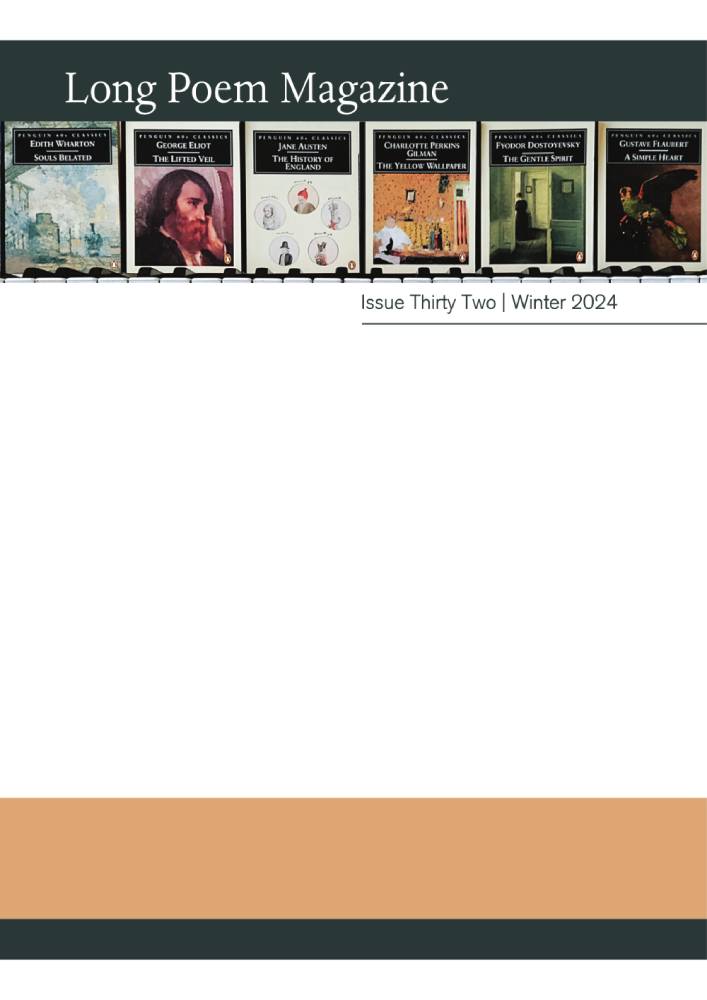A long poem is not a momentary thing. The necessary turn of more than one page demands a sit down and relax approach. Poets work hard on each page, each stanza, each line, each word of short poems – how long can you keep up that degree of care when there are so many more lines? Every poet in this issue (in every issue) of LPM has kept going, with unwavering dedication. You can tell that from the poets’ introductions about their process.
Given the way in which the poem is created, time is part of the joy and even part of the narrative itself. There is, often, a narrative in a long poem, whether time and story-based or an evocation of time created by the very time it takes to write/read.
Charlie Baylis, in his introduction to ‘White Flowers’, says: ‘at the inquest into my father’s death I learnt the exact time he died. This struck me as a unique piece of information – so I kept it for the poem.’ Time handcuffs exactness to our lives and this works for many poems. Claire Cox outlines her process in ‘Of Vulnerability’: ‘The initial journaling format, which used dates and times of day to title each set of two sonnets, has been streamlined here to let the reader piece together the incremental flow of information for themselves.’
Memory allows time to enter the poem as Alistair Lawrie explains: ‘The memory is of a magical and near surreal moment, a kind of epiphany in which were crystalised: a consciousness of time; the relativity and yet impossible distances of human experience; the inevitability of change, decay; and the imminence of mortality.’ And some of our poets attempt to analyse present time, as Fred D’Aguire does in ‘Full Disclosure Blues’:
Is this a bad time to make cents?
This is a good place to grow sense.
Fossils fuel coral colors votes.
come time
not much
adds up
these daze
Time makes us vulnerable. In ‘Gaze’, a study of Victorine Meurent, who worked as an artist’s model, Angela Gardner writes:
she is her own body
even as she touches our precarity seen and unseen, aware
of our imminent absence
We are ephemeral. S.L. Holm suggests a long poem helps create the feeling of our life cycle in the introduction to her poem ‘Mother like a vernal pool’: ‘This extended form allows the poem the space and pace to give what I hope is an ephemeral shimmer to various ideas of mothering, aging and the natural cycle of life and death.’ Time will finish us, for good or bad. Patrick Davidson Roberts brings his poem ‘The Final Summit’ to its final metaphorical loss of self by framing and placing the ascent of an emotional mountain in night-time:
and we fought in a version of love that was falling
and went on past midnight, until we were shocked
at the everything summoned in such a high state
and the valleys below that were drained of ourselves’
Tim Liardet explains this with lucidity and insight in his essay, ‘A Recurring Wave of Arrival’: ‘A long poem is a matter of duration. Like Bergson’s notion of time, once it is written and has cut its critical path through time, it becomes an indestructible whole. If a poem is twenty pages long with thirty-five lines per page, say, given the accumulation of sounds and volume of words, conceits and intended digressions, how does it ensure that it ‘gets there,’ so to speak; how does it ensure that it arrives on time without sagging or dropping in energy, pausing for too long, backtracking, repeating by mistake or worst of all, losing its way?’
He explains many approaches: ensuring the long poem has plenty of energy, using the poetic version of a musical riff to get the reader back on track, and even engaging the reader in periodic silences throughout the work (as shorter poems also can do).
Pausing to reflect is part of the pleasure of reading a long poem. We are delighted that poets share their lengthy work with us and that so many readers enjoy our poems by taking time to absorb them.
Claire Crowther November 2024
